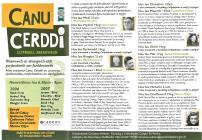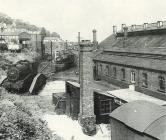Content can be downloaded for non-commercial purposes, such as for personal use or in educational resources.
For commercial purposes please contact the copyright holder directly.
Read more about the The Creative Archive Licence.
Description
Lede
The beach at Goodwick might appear flat and featureless, but looks can be deceiving.
Story
Stand on the Parrog at Goodwick when the tide is low and look across to the ferry terminal. Before you lies a large expanse of flat sand, firm to walk on, but with a myriad of ankle-deep puddles. On the far-side, below the steel gantry frame over the road are the jumbled rocks of an old fishtrap. On the sand a few darker shapes can be made out poking through. More rocks? Or perhaps something a little different?
The answer is the latter, for Goodwick Sands are full of archaeological remains. Some are very recent – old keep-pots and mooring footings – while others are older, and for a maritime archaeologist, more interesting. At least two shipwrecks are located here, of which only the ends of the frames and some planks poke through ripples of the sand. They are easy to miss, even when you stand next to them, but their outlines suggest that large sections of ship hull are probably preserved beneath your feet. Their extent is only full revealed through an overhead photograph.
The first wreck, labelled within the National Monuments Record of Wales (NMRW) as ‘Goodwick Wreck 1’ is 100m NE of the Ocean Lab slipway. It is a small ship, around 15m in length and possibly lying on its side – it’s very hard to tell from the visible remains. Recent archaeological fieldwork by the Royal Commission on the Ancient and Historical Monuments of Wales (RCAHMW) has been testing archaeological geophysics at the site to see how effective it is when used on a beach. Using this technique on an area with a known, but largely buried, shipwreck is perfect for testing how well that type of archaeological material shows up. The RCAHMW have been doing similar work at Whitesands near St Davids, and Albion Sands near Marloes.
But what about the identity of Goodwick Wreck 1? Currently the name and origin of the ship is unknown. But the NMRW has records of thirty-four vessels lost on Goodwick Sands alone, plus many more in Fishguard Bay. Once we fully understand the archaeological remains, matching it to historical records should be possible. In the meantime, we are always on the look out for old photos, postcards, paintings or other historical records that mention or show ships at Goodwick Sands.





Do you have information to add to this item? Please leave a comment
Comments (0)
You must be logged in to leave a comment